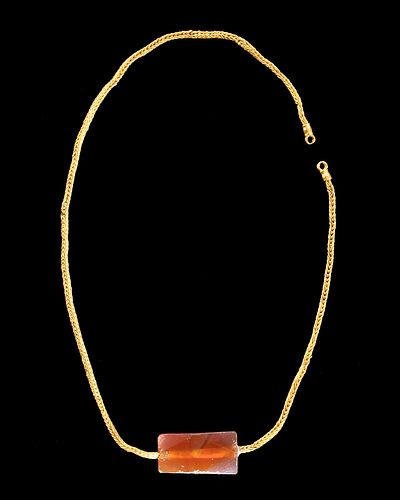Greek 22K+ Gold Braided Necklace w/ Carnelian Pendant
Lot 26a
About Seller
Artemis Gallery
686 S Taylor Ave, Ste 106
Louisville, CO 80027
United States
Selling antiquities, ancient and ethnographic art online since 1993, Artemis Gallery specializes in Classical Antiquities (Egyptian, Greek, Roman, Near Eastern), Asian, Pre-Columbian, African / Tribal / Oceanographic art. Our extensive inventory includes pottery, stone, metal, wood, glass and textil...Read more
Categories
Estimate:
$7,000 - $10,000
Absentee vs Live bid
Two ways to bid:
- Leave a max absentee bid and the platform will bid on your behalf up to your maximum bid during the live auction.
- Bid live during the auction and your bids will be submitted real-time to the auctioneer.
Bid Increments
| Price | Bid Increment |
|---|---|
| $0 | $25 |
| $300 | $50 |
| $1,000 | $100 |
| $2,000 | $250 |
| $5,000 | $500 |
| $10,000 | $1,000 |
| $20,000 | $2,500 |
| $50,000 | $5,000 |
| $100,000 | $10,000 |
| $200,000 | $20,000 |
About Auction
By Artemis Gallery
Feb 13, 2020
Set Reminder
2020-02-13 10:00:00
2020-02-13 10:00:00
America/New_York
Bidsquare
Bidsquare : Exceptional Antiquities, Asian, Ethnographic
https://www.bidsquare.com/auctions/artemis-gallery/exceptional-antiquities-asian-ethnographic-4848
An important one-day auction featuring museum-worthy examples of Egyptian, Greek, Roman, Etruscan, Near Eastern, Far East / Asian, Pre-Columbian, African / Tribal, Oceanic, Native American, Spanish Colonial, Russian, Fossils, Ancient Jewelry, Fine Art, so much more! Artemis Gallery info@artemisgallery.com
An important one-day auction featuring museum-worthy examples of Egyptian, Greek, Roman, Etruscan, Near Eastern, Far East / Asian, Pre-Columbian, African / Tribal, Oceanic, Native American, Spanish Colonial, Russian, Fossils, Ancient Jewelry, Fine Art, so much more! Artemis Gallery info@artemisgallery.com
- Lot Description
Ancient Greece, Classical period, ca. 5th to 4th century BCE. A petite and delicate accessory formed from braided wires of 95.5% gold (equivalent to 22K+) that create a beautiful cord. Each terminal is fitted with a slightly crimped and lightly carinated gold cap bearing integral loops on top that enable the piece to be worn as a necklace or a double-wrapped bracelet. Resting off-center on the braided band is a thick carnelian pendant of a rectangular form with slanted facets on the corners of each face. Braided gold necklaces were some of the most meticulous and painstakingly created types of gold jewelry crafted by ancient Greek artisans, so surviving examples are some of our most opulent glimpses into the past. Size (necklace): 14" L (35.6 cm); (quartz pendant): 1" W x 0.55" H (2.5 cm x 1.4 cm); quality of gold: 95.5% (equivalent to 22K+); total weight: 15.7 grams.
For a stylistically similar example of a braided necklace with lion-head terminals, please see The Metropolitan Museum of Art, accession number 74.51.3660.
Another stylistically similar example, from the Hellenistic Period and of a slightly longer size, hammered for $15,000 at Christie's, New York "Ancient Jewelry: Wearable Art" online auction (sale 14573, November 29 - December 8, 2016, lot 27).
Provenance: ex-private London, UK collection, acquired in 2011; ex-private Swiss collection, acquired in the 1960s
All items legal to buy/sell under U.S. Statute covering cultural patrimony Code 2600, CHAPTER 14, and are guaranteed to be as described or your money back.
A Certificate of Authenticity will accompany all winning bids.
We ship worldwide and handle all shipping in-house for your convenience.
#152772Wearable as shown. Minor repairs to roughly eight areas of gold chain, with small fissures to some strands, and light stabilization material in repaired areas. Slight bending to overall form of some braided wires, with nicks and abrasions to carnelian pendant. Nice gold luster throughout.Condition
- Shipping Info
-
All shipping is handled in-house for your convenience. Your invoice from Artemis Gallery will include shipping calculation instructions. If in doubt, please inquire BEFORE bidding for estimated shipping costs for individual items.
-
- Buyer's Premium



 EUR
EUR CAD
CAD AUD
AUD GBP
GBP MXN
MXN HKD
HKD CNY
CNY MYR
MYR SEK
SEK SGD
SGD CHF
CHF THB
THB















